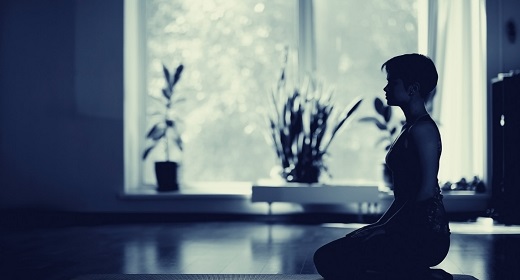by Marlynn Wei, MD, JD: Yoga is a gentle and restorative way to wind down your day. A national survey…
found that over 55% of people who did yoga found that it helped them get better sleep. Over 85% said yoga helped reduce stress. You can use supportive props like bolsters, blankets, and blocks to make poses comfortable so that you can stay in the pose for longer and continue to breathe.
Your breath is key to be able to relax in these poses. Breath in yoga is equally important—if not more important—as the physical pose. Use a gentle and calming yoga breath technique called Ujjayi Breath, also known as Ocean Breath or Victorious Breath. Inhale deeply through the nose. With your mouth closed, exhale through your nose while constricting the back of your throat as if you are saying “ha” but keep your mouth closed. This exhalation should sound like the waves of the ocean (or like Darth Vader from Star Wars). Use this slow and steady breath to soothe yourself in each of these poses.
Practice these yoga poses right before bedtime and stay in them about 3 to 5 minutes each. Use your Ocean Breath in each pose, with the exception of Corpse Pose, where your breath returns to normal.
These seven restorative yoga poses relieve tension and stress at the end of the day. The more that you practice these poses regularly, the more you likely you can get a good night’s rest.
1. Wide-Knee Child’s Pose (Balasana)

Image: iStock

Image: iStock
This resting pose provides a sense of calm and stability. Be cautious if you have hip or knee injuries.
- Kneel on the floor and bring your big toes together.
- Separate your knees hips width apart or as wide as the edges of the mat.
- Exhale and sink your torso onto your thighs.
- Let your hands relax alongside your torso, so your arms are pointed to the back of the room, palms facing up. This should release shoulder tension by widening your shoulder blades away from each other.
- If you want a more active pose, reach your hands forward, palms down on the mat.
- Keep your forehead on the ground. Roll your head to each side gently. This releases tension in your brow.
- Take slow and steady breaths, in and out through your nose.
2. Standing Forward Bend (Uttanasana)

Image: iStock
- Stand with your feet hips width apart. Inhale deeply.
- Exhale and extend your torso forward and over your legs to elongate your spine.
- Hold onto your elbows or let your hands rest on your shins or the floor.
- Do not strain to reach the floor—the purpose is not to achieve a perfect shape, but is to elongate the spine and relax your neck and shoulders.

Image: iStock
- This forward bend allows you to relax your neck tension and gently stretches your hamstrings, calves, and hips. Be careful if you have a back injury.
- If it is difficult for your hands to reach the floor or your back is uncomfortable, place blocks under each hand to provide more support.
- Breathe in and out through your nose slowly and smoothly.
- If you have tight hamstrings, keep your knees “soft” by bending them slightly so thatyour chest can relax on your thighs.
- Gently shake your head “yes” and “no” to relax and loosen your neck muscles.
- To come up, roll up slowly to standing to avoid getting light-headed.
3. Standing Half Forward Bend (Ardha Uttanasana) at the wall
This is another modification of the pose, standing forward bend. Video available here.

Image: iStock
- Place your mat perpendicular to the wall.
- Stand about a foot away from the wall.
- Your feet should be hips width apart and parallel to the edges of the mat.
- Press your hands against the wall with your palms spread at the height of your hips.
- Step back with your feet hips width apart and lower your torso until you come into a flat back position, so that your torso is perpendicular to the floor.
- Use your palms to press the wall away from you to lengthen your back.
- Press into all four corners of your feet.
- Keep your ears in line with your arms.
- Adjust your distance from the wall to make sure your body is at a 90-degree angle (L shape). If you are too close to the wall, your back and arms will not be able to be fully extended. If you are too far from the wall, you will not be able to bend forward enough.
- Continue to breathe deeply as you press the wall away from you with your palms.
4. Reclining Bound Angle (Supta Baddha Konasana)

Image: iStock
This pose eases tension in your hips and groin area. Be cautious if you have knee, hip or groin injuries.
- Lie down on the mat.
- Bend your knees, and place your feet on the floor, close to your tailbone.
- Bring the soles of your feet together and allow your knees to relax away from each other, while placing blocks or firm cushions underneath your knees on each side to support your hips.
- If you have tight hips, you can adjust your feet so that they are further away from your tailbone or add more blocks or cushions under your knees for additional height.
- Relax your arms on the floor about 45 degrees away from your torso, palms facing the ceiling.
- Do not press down on knees to create additional tension. Gravity is already doing the work.
- You should feel a gentle stretch in your hips and groin, but it should not be painful.
5. Legs Up The Wall Pose (Viparita Karani )

Image: iStock
At the end of the day, especially if your job involves staying on your feet, your feet and ankles can get swollen and tired. This simple pose helps recirculates your blood flow.
- Find an empty space on your wall and place your mat perpendicular to the wall.
- Sit down on the mat and bring your left or right side to the wall as close as possible, so your side body meets the wall.
- Lie back onto mat, and gently place your legs up the wall.
- Relax your arms by your sides.
Optional: You can add a rolled up mat or firm cushion underneath your tailbone to give your tailbone added support.
6. Corpse Pose (Savasana)

Image: iStock
Corpse pose is the traditional final resting pose of yoga practice. You can let your breath return to normal in this pose.
- Lie back on the mat.
- Hug your knees in towards your chest tightly and take a deep inhale.
- Exhale and stretch your legs out away from you while keeping your tailbone grounded on the mat.
- Your feet should be hips width apart and relaxed away from each other, toward the edges of the mat.
- Let your lower back soften and relax. You should not feel any pain or tightness in your lower back.
- Relax your arms at your sides, palms facing upward.
- Check to make sure your shoulders are not hunched, and, if so, relax your shoulders away from your ears.
- Optional: Place a folded towel over your eyes to block out any light.
7. Legs on a Chair Pose
This pose is useful for people who might have more difficulty fully extending their legs up the wall due to lower back, knee, or hip injuries. You can find a video of how to get into this pose here.
- Place a chair at the end of your yoga mat so that it faces you.
- Place a folded towel or blanket on the seat of the chair. Depending on the height of the chair, you may need a few folded blankets under your sacrum as well.
- Sit close on the mat, with your seat close to the front of the chair.
- Lie down on one side with knees bent in fetal position. Scoot onto the center of the mat.
- Roll onto your back with bent knees so that your calves can rest on the seat of the chair.
- Your thighs should be at a 90-degree angle to your shins.
- Keep your arms relaxed at your sides, palms facing up.
Source: Harvard

















































